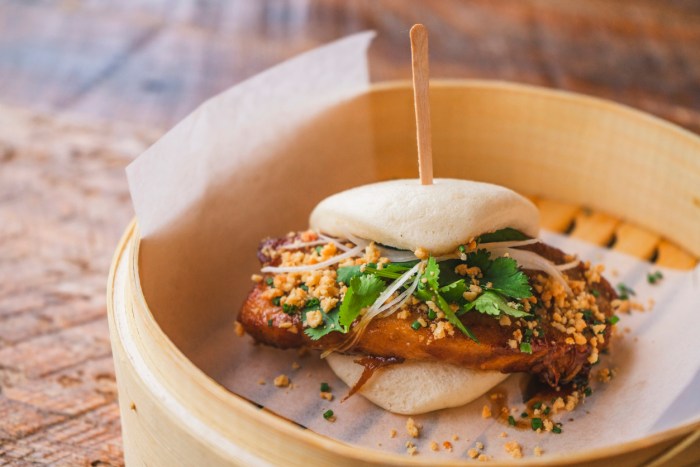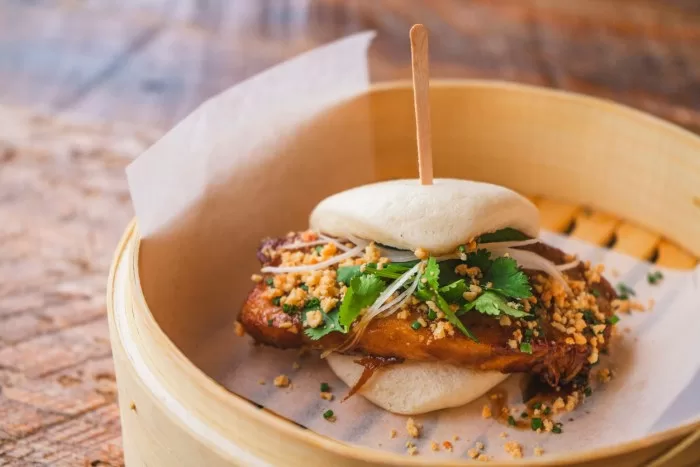Embark on a culinary adventure with Experimenting with Fusion Cuisine, a captivating exploration into the vibrant world where flavors dance across borders and cultures intertwine. This culinary journey unveils the techniques, ingredients, and cultural influences that shape this innovative approach to gastronomy.
Fusion cuisine, a harmonious blend of culinary traditions, invites us to savor the unexpected, as chefs weave together the flavors of the world, creating dishes that tantalize our taste buds and broaden our culinary horizons.
Fusion Cuisine
Fusion cuisine, a culinary trend that emerged in the late 20th century, blends elements from different culinary traditions, creating innovative and unique dishes. Its origins can be traced to the increasing globalization and cultural exchange, which exposed chefs to a wider range of flavors and techniques.
Fusion dishes often combine ingredients and techniques from diverse cuisines, resulting in harmonious and unexpected flavors. Common techniques used include marinating, stir-frying, and grilling, while ingredients may include spices, herbs, and sauces from various cultures. The aim is to create a cohesive and balanced dish that transcends cultural boundaries.
Successful Fusion Cuisines
Many successful fusion cuisines have emerged worldwide, showcasing the creativity and adaptability of chefs. Notable examples include:
- Tex-Mex (Mexican and American): A blend of Mexican flavors and American ingredients, resulting in dishes like tacos, burritos, and fajitas.
- Chindian (Chinese and Indian): A fusion of Chinese cooking techniques with Indian spices and flavors, creating dishes like Manchurian and Szechuan fried rice.
- Nikkei (Japanese and Peruvian): A fusion that combines the delicate flavors of Japanese cuisine with the bold flavors of Peruvian ingredients, resulting in dishes like ceviche and tiradito.
Experimenting with Flavors
Experimenting with flavors is key to creating successful fusion dishes. Chefs can combine different cuisines and ingredients to create new and exciting flavor profiles.
Experimenting with fusion cuisine involves blending diverse culinary traditions to create innovative dishes. Incorporating exotic ingredients can elevate these culinary creations by adding unique flavors, textures, and aromas. For those seeking to explore exotic ingredients in their home cooking, a wealth of information can be found at Exotic ingredients for home cooking . By utilizing these ingredients, home cooks can push the boundaries of their culinary repertoire and create truly memorable fusion cuisine experiences.
One way to create harmonious flavor combinations is to use the flavor wheel. The flavor wheel is a tool that organizes flavors into different categories, such as sweet, sour, salty, bitter, and umami. By using the flavor wheel, chefs can identify complementary flavors that will work well together.
Spices, Herbs, and Condiments
Spices, herbs, and condiments play an important role in fusion cuisine. They can be used to add flavor, depth, and complexity to dishes. When using spices, herbs, and condiments, it is important to consider their individual flavors and how they will interact with the other ingredients in the dish.
Unexpected Ingredients
Incorporating unexpected ingredients into dishes can add a unique and surprising element. Some examples of unexpected ingredients that can be used in fusion cuisine include fruits, vegetables, and even flowers.
Experimenting with fusion cuisine offers a unique opportunity to combine flavors and techniques from different culinary traditions. By embracing the principles outlined in Gourmet dishes made easy , aspiring chefs can transform everyday ingredients into extraordinary culinary creations. This approach not only enhances the taste experience but also allows for creative expression and exploration of diverse food cultures.
By seamlessly blending elements from various cuisines, fusion cooking empowers individuals to craft innovative and unforgettable dishes that push the boundaries of gastronomy.
Kitchen Recipes: Experimenting With Fusion Cuisine
Fusion cuisine presents a culinary adventure where diverse flavors and techniques converge to create innovative dishes. To embark on this gustatory exploration, we present a curated selection of fusion recipes that showcase bold flavor combinations and imaginative approaches.
Recipe Table
To guide your culinary journey, we have designed a recipe table that Artikels the essential elements of each fusion creation. This table includes:
- Dish Name: The captivating title of the dish.
- Ingredients: A comprehensive list of the ingredients required to craft the culinary masterpiece.
- Instructions: Step-by-step guidance to navigate the culinary process.
- Image Description: A vivid portrayal of the dish’s visual appeal.
| Dish Name | Ingredients | Instructions | Image Description |
|---|---|---|---|
| Fusion Paella |
|
|
A vibrant and aromatic paella that combines the flavors of Spain and Mexico, featuring succulent seafood, spicy chorizo, and a flavorful broth infused with saffron. |
| Thai Green Curry Lasagna |
|
|
A harmonious blend of Italian and Thai flavors, this lasagna offers a unique twist with its aromatic green curry sauce, tender chicken or tofu, and a medley of vegetables. |
| Sushi Burrito |
|
|
A delightful fusion of Japanese and Mexican cuisine, this sushi burrito combines the delicate flavors of sashimi, avocado, and cucumber with the bold spices of spicy mayo and soy sauce, all wrapped in a crispy nori sheet. |
Presentation: A Culinary Canvas

Presentation plays a pivotal role in elevating the dining experience in fusion cuisine. It transforms the plate into a canvas, where the chef’s artistry and culinary innovation come to life.
Plating techniques and garnishes are essential elements in creating visually stunning dishes. Chefs employ a range of techniques, such as layering, molding, and arranging ingredients to create a visually appealing composition. Garnishes, like herbs, microgreens, and edible flowers, add pops of color, texture, and aroma, enhancing the dish’s overall presentation.
Plating Techniques
- Stacking and Layering: Superimposing ingredients vertically creates depth and height, adding visual interest to the dish.
- Molding and Shaping: Using molds or shaping techniques, chefs transform ingredients into unique and eye-catching forms.
- Negative Space: Leaving empty spaces on the plate allows the main elements to stand out, creating a sense of balance and elegance.
Garnishes
Garnishes serve multiple purposes beyond aesthetics. They can balance flavors, add texture, and complement the dish’s theme. Common garnishes include:
- Herbs: Fresh herbs like basil, cilantro, and parsley add a burst of color, aroma, and subtle flavors.
- Microgreens: Tiny, edible greens add a delicate crunch and a touch of vibrant color.
- Edible Flowers: Edible flowers, such as pansies and nasturtiums, add a touch of elegance and a subtle floral flavor.
Examples of Visually Stunning Fusion Dishes, Experimenting with fusion cuisine
Fusion cuisine offers endless possibilities for visually stunning dishes. Here are a few examples:
- Deconstructed Sushi Burrito: A fusion of sushi and Mexican cuisine, this dish features deconstructed sushi ingredients rolled into a tortilla.
- Molecular Gastronomy Foie Gras: This dish transforms foie gras into a sphere using molecular gastronomy techniques, creating a visually appealing and texturally unique experience.
- Spicy Mango Sticky Rice: A Thai-inspired dish that combines sweet and spicy flavors, with sticky rice molded into a pyramid and topped with a mango salsa.
Cultural Influences: A Global Melting Pot

Fusion cuisine is a culinary tapestry woven from the vibrant threads of diverse cultures. It draws inspiration from various culinary traditions, blending flavors, techniques, and ingredients to create a harmonious symphony of taste.
The evolution of fusion dishes has been influenced by a myriad of factors, including:
Immigration and Globalization
The movement of people across borders has played a pivotal role in the spread of fusion cuisine. Immigrants bring their culinary heritage to their new homes, introducing novel ingredients, cooking methods, and flavor profiles. Globalization has further accelerated this exchange of culinary ideas, making it possible for cuisines from distant lands to interact and influence each other.
Culinary Curiosity and Experimentation
The rise of fusion cuisine is also driven by the insatiable curiosity of chefs and diners alike. Chefs experiment with different cuisines, seeking to create innovative and exciting dishes that push the boundaries of culinary tradition. Diners, in turn, are eager to explore new flavors and culinary experiences, embracing the fusion of different cuisines.
Economic Factors
Economic factors have also influenced the development of fusion cuisine. The availability of ingredients from around the world has made it possible for chefs to experiment with a wider range of flavors and textures. Additionally, the rise of international tourism has created a demand for dishes that cater to the tastes of a global clientele.
Last Recap
Experimenting with fusion cuisine is not merely a culinary endeavor; it is a testament to the power of cultural exchange and the boundless creativity of the human palate. As we continue to explore and innovate in the realm of fusion cuisine, we not only expand our culinary repertoire but also foster a greater appreciation for the diverse tapestry of global flavors.
Key Questions Answered
What are the key techniques used in fusion cuisine?
Fusion cuisine often employs techniques such as combining contrasting flavors, incorporating unexpected ingredients, and experimenting with various cooking methods to create unique and harmonious dishes.
How does cultural background influence fusion cuisine?
Cultural background plays a significant role in shaping fusion cuisine, as chefs draw inspiration from their own culinary traditions and incorporate elements from other cultures, resulting in a diverse and ever-evolving culinary landscape.
What are some examples of successful fusion cuisines?
Notable examples of successful fusion cuisines include Tex-Mex (Mexican and American), Peruvian-Japanese (Nikkei cuisine), and Indian-Chinese (Hakka cuisine), showcasing the boundless possibilities of culinary innovation.


